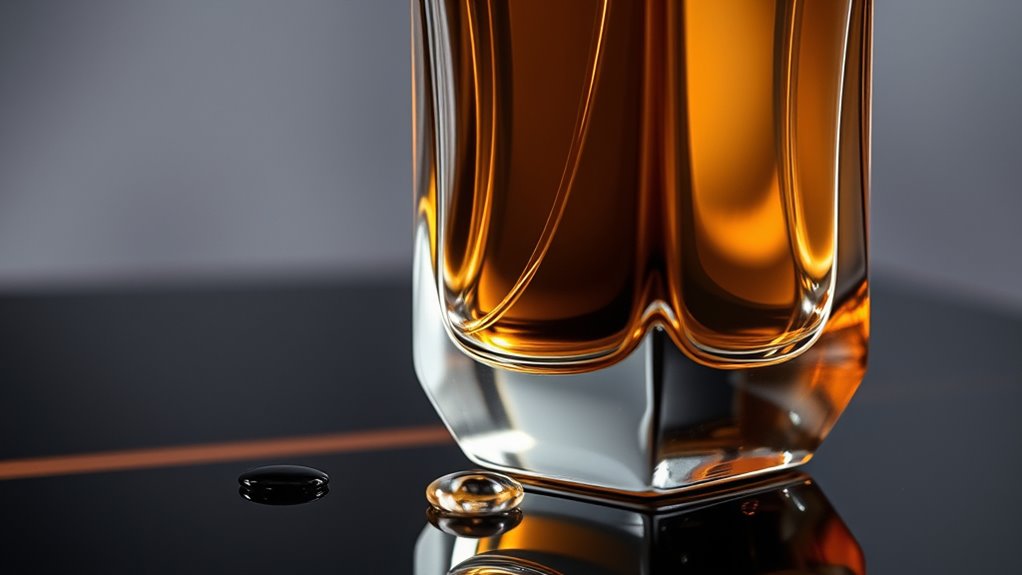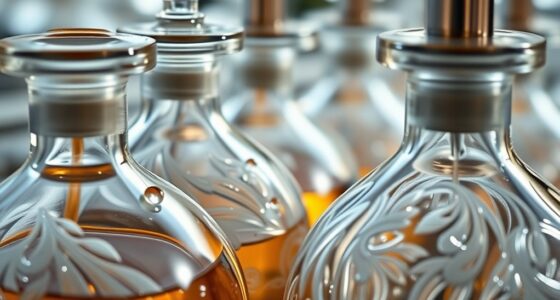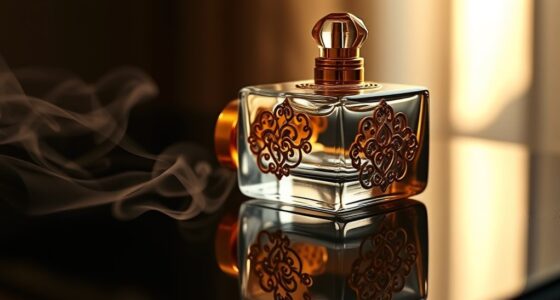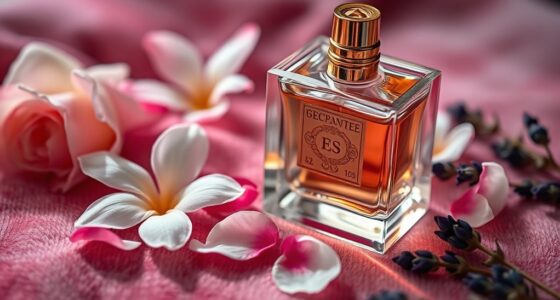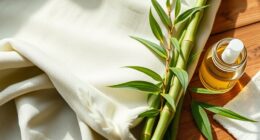Perfume concentrations vary in strength, longevity, and sillage, influencing how a scent performs and feels. Parfum or extrait de parfum has the highest concentration (20-40%), offering a rich, long-lasting aroma that makes a statement. Eau de toilette and cologne have lower concentrations (5-15%), providing lighter, more subtle scents suitable for everyday wear. Your choice depends on your preference for intensity, duration, and occasion. To better understand these differences, explore more about perfume types and their unique qualities.
Key Takeaways
- Perfume concentrations range from 20-40% for parfum to 5-15% for eau de toilette, affecting scent intensity.
- Higher concentrations produce longer-lasting, more powerful scents with greater projection and sillage.
- Lower concentrations are lighter, subtler, and suitable for everyday wear or warmer climates.
- The concentration level influences how long the fragrance lasts and how much it projects around you.
- Choosing the right concentration depends on occasion, personal preference, and desired scent strength.
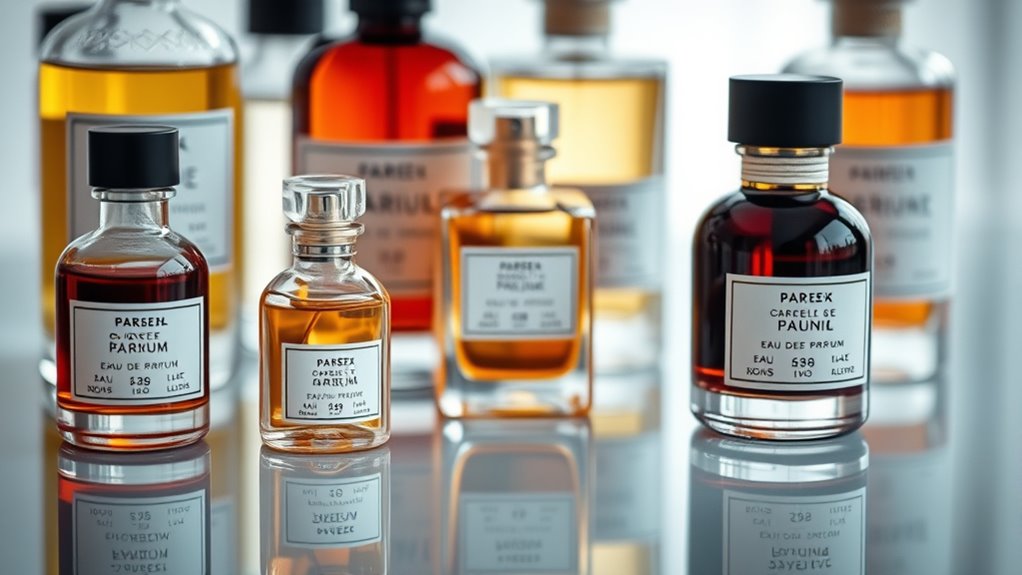
Have you ever wondered what distinguishes one perfume from another? It all comes down to the concentration of fragrance oils in the formula. Perfume concentrations directly influence how a scent performs in terms of sillage intensity and longevity differences. When you choose a perfume, you’re not just picking a fragrance; you’re selecting how it will project and how long it will last on your skin. Higher concentrations, like parfum or extrait de parfum, contain more fragrance oils—usually between 20% and 40%. This means they tend to have a richer, more intense scent that lingers longer. Because of their higher oil content, these perfumes usually produce a stronger sillage, meaning they leave a more noticeable trail as you move. You’ll find that parfum lasts several hours, often up to eight or more, making it ideal for special occasions or when you want your scent to stay with you all day. Additionally, the composition of ingredients in higher-concentration perfumes often includes more complex blends that contribute to a richer scent profile.
On the other hand, eau de toilette and eau de cologne have lower concentrations—typically between 5% and 15%. These lighter formulas offer a more subtle scent experience, with less sillage intensity and shorter longevity differences. They’re perfect for everyday wear or warmer weather when you prefer a more fleeting fragrance that doesn’t overpower. Because they contain less fragrance oil, these scents tend to fade faster, often lasting just a few hours. The difference in longevity is noticeable; they might need reapplication throughout the day to maintain the scent. This makes them more versatile if you like switching fragrances or prefer a less intense presence.
Understanding the relationship between concentration, sillage, and longevity helps you make smarter choices based on your needs. If you want a perfume that makes a statement and lasts through your busy day, a higher concentration like parfum is your best bet. But if you prefer a lighter, more invigorating scent that’s easy to reapply, then an eau de toilette or cologne suits you better. Keep in mind that the quality of the ingredients also plays a role—higher-quality oils can extend both sillage and longevity even within lower concentration categories. So, when you’re shopping, consider how much projection you want and how long you need the scent to last, then choose accordingly. Ultimately, knowing these differences empowers you to select fragrances that match your lifestyle and personal style perfectly.
Frequently Asked Questions
How Do Perfume Concentrations Affect Scent Longevity?
You’ll notice that higher perfume concentrations, like extrait or parfum, make your scent last longer, so you enjoy your fragrance throughout the day. They also enhance sillage and projection, helping your scent leave a memorable trail. Using fragrance layering techniques with different concentrations can boost longevity even more. Lower concentrations, like eau de cologne, tend to fade faster, so you might need to reapply if you want consistent scent presence.
Are Higher Concentrations Always More Expensive?
Higher concentrations often cost more due to luxury branding and the quality of ingredients used. However, price isn’t always the best indicator of value; some fragrances with lower concentrations can be equally luxurious. When scent layering, you might prefer a lighter perfume for versatility or a richer one for depth. Ultimately, choose based on your preferences and how the scent complements your style, not just price.
Can Perfume Concentration Change Over Time?
Yes, perfume concentration can change over time. Exposure to light, heat, and air can cause the scent to degrade or alter. To maintain your fragrance’s original concentration, practice scent layering by combining complementary scents, and follow storage tips like keeping bottles in a cool, dark place. This helps preserve the perfume’s integrity, ensuring it stays true to its intended strength and aroma longer.
How Should I Choose a Perfume Based on Concentration?
Choosing a perfume based on concentration is like selecting the right brush for a painting—each one shapes your masterpiece differently. If you want a subtle aura, opt for eau de toilette; for bold scent projection, go for parfum. Consider how you’ll do fragrance layering to enhance longevity and projection. Your choice depends on whether you prefer a whisper or a statement, tailoring your scent’s strength to suit your style.
Do Perfume Concentrations Impact Skin Sensitivity?
Yes, perfume concentrations can impact your skin sensitivity. Higher concentrations like extrait or perfume can increase the risk of allergic reactions because they contain more fragrance oils, which may irritate sensitive skin. If you have sensitive skin or are prone to allergic reactions, opt for lower concentrations like eau de toilette or spray, and always do a patch test first. This way, you guarantee better skincare compatibility and reduce irritation risks.
Conclusion
Now that you understand perfume concentrations, you hold the key to revealing scent’s true soul. Like a master painter blending colors, you can choose the perfect intensity to match your mood and style. Whether you want a whisper of fragrance or a commanding presence, each concentration paints a different story on your skin’s canvas. Embrace this knowledge, and let your scent become the silent poetry that speaks volumes about who you are.
